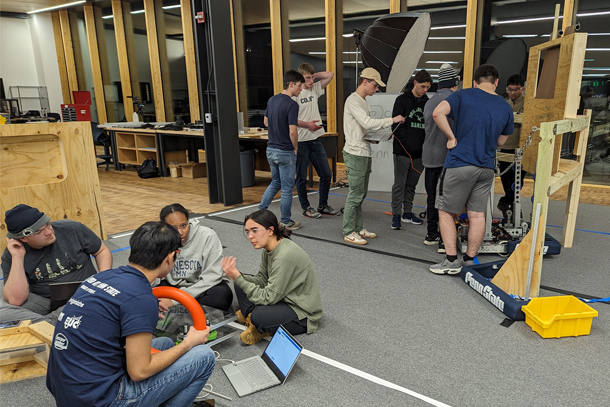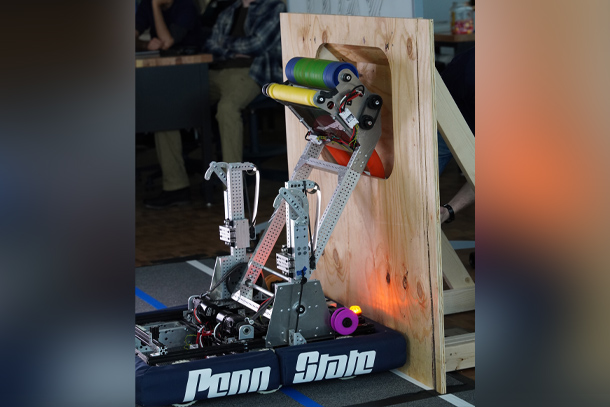
Members of the RI3D club work on prototype testing in the Engineering Design and Innovation Building. Credit: Provided/Sophia Balaratna
How to build a robot in three days
New Penn State facilities provide home for rapid robotics competition and K-12 STEM outreach
May 1, 2024
By Sarah Small
UNIVERSITY PARK, Pa. — One engineering student organization, two new campus makerspaces and three days resulted in a functioning robot and a weekend-long demonstration of student ingenuity and outreach at Penn State.
Earlier this semester, the Penn State Robot in Three Days (Ri3D) club participated in the national FIRST Robotics competition, where students are tasked with designing, prototyping and building a robot in just 72 hours. The group of 30 students, mostly engineering majors, successfully transformed 125 pounds of material into a functional, task-completing robot, built within the College of Engineering’s Engineering Design and Innovation (EDI) Building and Invent Penn State’s OriginLabs — both constructed roughly within the past year.
“Ri3D got the incredible opportunity to be one of the first major events based in Penn State’s new Engineering Design and Innovation Building,” said Mattias King, second-year mechanical engineering student and president and founder of Ri3D at Penn State.
According to King, the club manufactured parts in the OriginLabs shop but was mainly based in the 24/7 open fourth floor of EDI.
“The space was perfect for large group brainstorming sessions, late-night whiteboard design and, most importantly, the reveal of the robot, which was programmed for achieving this year’s challenge: top pick up and score foam rings into a target and to lift the robot off the ground using a hanging chain,” he said. “OriginLabs, a prototyping and fabrication center located downtown just across the street from Hammond, also made Ri3D possible by opening its doors to us on the weekend and providing tooling and technical support.”

The team built a robot that was able to score a foam ring. Credit: Provided/Jackson Wood
The club, active year-round, recorded and explained their progress in both facilities throughout the weekend, which the students now use for outreach to high school students interested in STEM, according to King. Ri3D is associated with the international FIRST Robotics competition, an event for high school students with more than 80,000 participants from around the world.
He said that while the Penn State team is only competing against the clock in their event, the group plays an important supportive and educational role for the high school participants. By posting their progress on social media through photos and several explanatory videos that provide a detailed look into the technical aspects of building a robot, they can inspire and assist high school students looking to improve their own methods of building.
“When the challenge is released by FIRST at noon on Saturday, our seven different subteams—mechanical, electrical, and so on—strategize together and then break off into our subgroups to work,” King said, noting that his older brother, Rio, is the lead of one team and his younger brother, Marco, leads the final video production. “Our media team aims to release a cinema-quality robot reveal by 7 p.m. on the final day of the competition. They storyboard, film, edit and publish a two-minute video in just seven hours.”
That video, a key component of outreach for high school STEM students, garnered more than 31,000 views. King said that the other, more technical videos represent the real purpose of Ri3D: to explain not only the mechanisms the team chose but also why they chose them and what else they tried first. The team also kept an active Instagram account leading up to and during their first competition.
While this was only year one for Ri3D at Penn State, King said they plan to build on this success in the future, further capitalizing on University tools and facilities like the EDI Building and OriginLabs, as well as student experience and enthusiasm, to design and build new robots and expand their outreach efforts.



